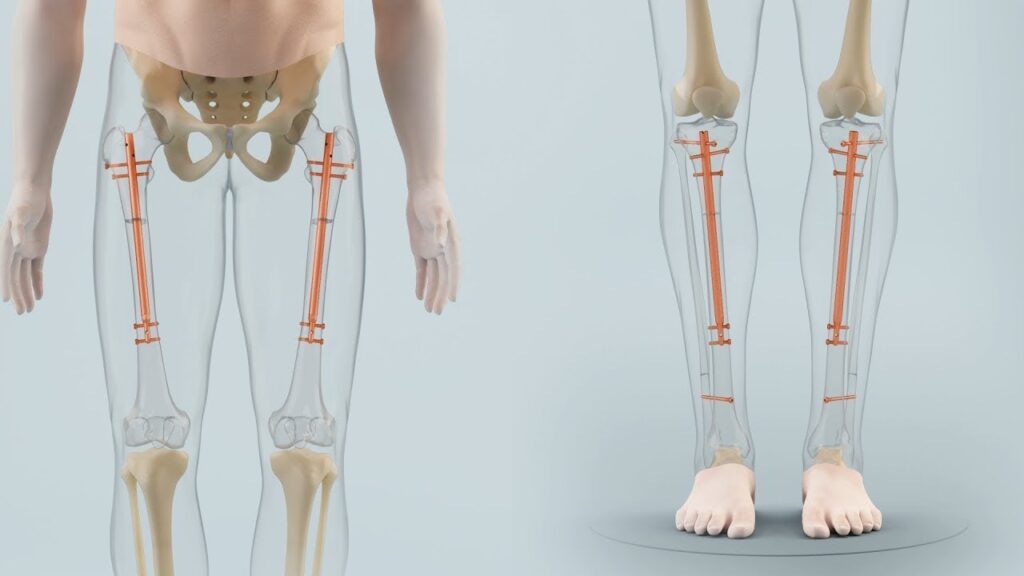Discover the medical conditions requiring limb lengthening surgery, including congenital disorders, trauma-related discrepancies, and growth abnormalities. Learn about the procedures and their benefits.

Outline
| Headings | Sub-Headings |
|---|---|
| Introduction | – Understanding Limb Lengthening Surgery |
| What is Limb Lengthening Surgery? | – Basic Overview |
| – History and Evolution | |
| Congenital Disorders Requiring Limb Lengthening | – Congenital Limb Length Discrepancy |
| – Fibular Hemimelia | |
| – Congenital Short Femur Syndrome | |
| Post-Traumatic Limb Length Discrepancies | – Bone Fractures |
| – Malunions and Nonunions | |
| – Growth Plate Injuries | |
| Growth Abnormalities | – Achondroplasia |
| – Hypochondroplasia | |
| – Other Skeletal Dysplasias | |
| Other Medical Conditions Requiring Limb Lengthening | – Neurofibromatosis |
| – Rickets | |
| – Blount’s Disease | |
| The Limb Lengthening Procedure | – Pre-Surgery Evaluation |
| – Surgical Techniques | |
| – Post-Surgery Care and Rehabilitation | |
| Benefits of Limb Lengthening Surgery | – Improved Mobility |
| – Enhanced Quality of Life | |
| – Psychological Benefits | |
| Risks and Complications | – Common Surgical Risks |
| – Long-Term Complications | |
| Success Stories and Patient Testimonials | – Real-Life Experiences |
| – Medical Case Studies | |
| Technological Advances in Limb Lengthening | – Modern Techniques |
| – Future Innovations | |
| FAQs | – |
| – What is limb lengthening surgery? | |
| – Who needs limb lengthening surgery? | |
| – What are the common conditions treated with limb lengthening? | |
| – How is the surgery performed? | |
| – What are the risks of limb lengthening surgery? | |
| – What advancements are being made in limb lengthening surgery? | |
| Conclusion | – |
Medical Conditions Requiring Limb Lengthening: Understanding the Need for Surgical Intervention
Limb lengthening surgery is a transformative procedure aimed at addressing various medical conditions that result in limb length discrepancies. This comprehensive guide explores the conditions that necessitate limb lengthening surgery, the procedures involved, and the benefits and risks associated with this surgical intervention.
Introduction
Limb lengthening surgery has revolutionized the treatment of limb length discrepancies, providing patients with enhanced mobility and improved quality of life. This procedure is vital for individuals with certain congenital disorders, trauma-induced discrepancies, and growth abnormalities.
What is Limb Lengthening Surgery?
Basic Overview
Limb lengthening surgery involves the gradual stretching of bones to increase their length. This is typically done through a surgical technique known as distraction osteogenesis, where the bone is cut and slowly separated to allow new bone tissue to form in the gap.
History and Evolution
The history of limb lengthening surgery dates back to ancient attempts using rudimentary methods. Modern techniques have evolved significantly, particularly with the development of the Ilizarov method in the mid-20th century, which has paved the way for advanced surgical interventions today.
Congenital Disorders Requiring Limb Lengthening
Congenital Limb Length Discrepancy
Congenital limb length discrepancy is a condition present at birth where one limb is significantly shorter than the other. This can affect the legs, leading to walking difficulties and other functional impairments.
Fibular Hemimelia
Fibular hemimelia is a congenital disorder characterized by the absence or underdevelopment of the fibula bone in the leg. Limb lengthening surgery can help equalize the length of the affected limb, improving mobility and function.
Congenital Short Femur Syndrome
Congenital short femur syndrome involves the underdevelopment of the femur (thigh bone) at birth. Limb lengthening procedures can correct the discrepancy, allowing for better balance and gait.
Post-Traumatic Limb Length Discrepancies
Bone Fractures
Severe bone fractures can lead to limb length discrepancies if the bones do not heal properly. Limb lengthening surgery can correct these discrepancies, restoring normal limb length and function.
Malunions and Nonunions
Malunions occur when fractured bones heal in an incorrect position, while nonunions refer to fractures that fail to heal. Both conditions can result in limb length discrepancies that may require surgical correction through limb lengthening.
Growth Plate Injuries
Injuries to the growth plates in children can disrupt normal bone growth, leading to limb length discrepancies. Limb lengthening surgery can address these issues, promoting equal limb length as the child grows.
Growth Abnormalities
Achondroplasia
Achondroplasia is a genetic disorder characterized by short stature due to abnormal bone growth. Limb lengthening surgery can increase the length of the limbs, improving overall height and mobility.
Hypochondroplasia
Hypochondroplasia is similar to achondroplasia but tends to be less severe. Limb lengthening procedures can help individuals achieve better limb proportions and functionality.
Other Skeletal Dysplasias
Various other skeletal dysplasias, such as multiple epiphyseal dysplasia and metaphyseal dysplasia, can result in limb length discrepancies. Limb lengthening surgery provides a viable solution for correcting these abnormalities.
Other Medical Conditions Requiring Limb Lengthening
Neurofibromatosis
Neurofibromatosis is a genetic disorder that can cause bone abnormalities, including limb length discrepancies. Limb lengthening surgery can help correct these differences, enhancing the patient’s mobility and quality of life.
Rickets
Rickets, caused by vitamin D deficiency, leads to weakened and deformed bones. Severe cases may result in limb length discrepancies that require surgical intervention through limb lengthening.
Blount’s Disease
Blount’s disease is a growth disorder affecting the shin bone, causing it to bend inward. Limb lengthening surgery can correct the deformity, restoring proper alignment and length.
The Limb Lengthening Procedure
Pre-Surgery Evaluation
Before undergoing limb lengthening surgery, patients must undergo a comprehensive medical evaluation, including imaging studies and physical assessments, to determine the appropriate treatment plan.
Surgical Techniques
The surgical technique involves cutting the bone (osteotomy) and using devices such as external fixators or internal lengthening nails to gradually separate the bone segments. This allows new bone tissue to form in the gap.
Post-Surgery Care and Rehabilitation
Post-surgery care is crucial for successful outcomes. It includes pain management, monitoring for complications, and physical therapy to maintain joint mobility and muscle strength during the bone lengthening process.
Benefits of Limb Lengthening Surgery
Improved Mobility
One of the primary benefits of limb lengthening surgery is improved mobility. Correcting limb length discrepancies allows patients to walk more easily and participate in physical activities.
Enhanced Quality of Life
Limb lengthening surgery can significantly enhance the quality of life by improving physical function, reducing pain, and increasing self-esteem.
Psychological Benefits
The psychological benefits of limb lengthening surgery are substantial. Patients often experience increased confidence and a better self-image following the procedure.
Risks and Complications
Common Surgical Risks
As with any surgical procedure, limb lengthening surgery carries risks such as infection, nerve damage, and blood clots. Surgeons take preventive measures to minimize these risks, but patients should be aware of potential complications.
Long-Term Complications
Long-term complications can include joint stiffness, muscle contractures, and unequal bone growth. Ongoing monitoring and rehabilitation are essential to manage and mitigate these issues.
Success Stories and Patient Testimonials
Real-Life Experiences
Many patients have shared their success stories following limb lengthening surgery. These testimonials highlight the transformative impact of the procedure on their mobility and quality of life.
Medical Case Studies
Medical case studies provide valuable insights into the outcomes and challenges of limb lengthening procedures. These studies contribute to the continuous improvement of techniques and patient care.
Technological Advances in Limb Lengthening
Modern Techniques
Modern techniques in limb lengthening surgery include advanced external fixators, motorized internal lengthening nails, and minimally invasive surgical methods. These innovations have improved precision and patient comfort.
Future Innovations
Future innovations in limb lengthening surgery may include the use of robotics, 3D printing, and regenerative medicine to enhance the precision, safety, and outcomes of the procedures.
FAQs
What is limb lengthening surgery?
Limb lengthening surgery is a procedure that involves cutting the bone and gradually stretching it to increase its length, allowing new bone tissue to form in the gap.
Who needs limb lengthening surgery?
Individuals with congenital limb length discrepancies, trauma-induced limb shortening, and certain growth abnormalities may require limb lengthening surgery.
What are the common conditions treated with limb lengthening?
Common conditions include congenital limb length discrepancy, fibular hemimelia, achondroplasia, neurofibromatosis, and post-traumatic limb length discrepancies.
How is the surgery performed?
The surgery involves cutting the bone (osteotomy) and using devices like external fixators or internal lengthening nails to gradually separate the bone segments, allowing new bone tissue to form.
What are the risks of limb lengthening surgery?
Risks include infection, nerve damage, joint stiffness, muscle contractures, and unequal bone growth. Preventive measures and careful monitoring help minimize these risks.
What advancements are being made in limb lengthening surgery?
Advancements include the development of motorized internal lengthening nails, minimally invasive surgical techniques, and potential future innovations like robotics and regenerative medicine.
Conclusion
Limb lengthening surgery is a critical intervention for various medical conditions that result in limb length discrepancies. By understanding the conditions that require this surgery, the procedures involved, and the potential benefits and risks, patients and healthcare providers can make informed decisions to improve mobility and quality of life.



